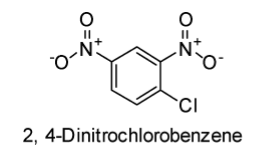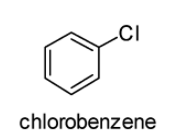
2, 4-Dinitrochlorobenzene is less reactive than chlorobenzene towards nucleophilic substitution. (State whether the given statements are True or False).
A. True
B. False
Answer
561.9k+ views
Hint:Nucleophilic substitution reactions are those reactions in which an electron rich nucleophile tends to attack a positively charged electrophile in order to replace a leaving group.
Complete answer:
The structures of 2, 4-Dinitrochlorobenzene and chlorobenzene are displayed below:


In case of chlorobenzene, the lone pair of electrons are delocalised on the benzene ring. Therefore, \[C - Cl\] bond tends to acquire the slight partial double bond character. As a result, \[C - Cl\] bond in the chlorobenzene molecule is very strong which cannot be broken easily.
In case of the 2, 4-Dinitrochlorobenzene, nitro-group (\[N{O_2}\]) is present, which is an electron-withdrawing group. Thus, presence of \[N{O_2}\] group at the para position tends to withdraw the electrons from the benzene ring and thereby facilitates the attack of nucleophiles on the para chlorobenzene. Hence, para nitrochlorobenzene seems to be more reactive towards the nucleophilic substitution reactions in comparison to chlorobenzene.
Therefore, the given statement i.e. 2, 4-Dinitrochlorobenzene is less reactive than chlorobenzene towards nucleophilic substitution, cannot be true.
Hence, the correct answer is Option B i.e. false.
Note:
In simpler terms, nucleophilic substitution reactions are those reactions in which an electron pair donor (i.e. a nucleophile say ‘Y’:) reacts with an electron pair acceptor (i.e. a substrate, say ‘R-X’) and which substitutes for the ‘X’ group (i.e. a leaving group). Let us look at the following generalized equation for nucleophilic substitution:
$Y{:^ - } + R - X \to Y - R + :{X^ - }$
Here, $R$ can be an alkyl or an aryl group.
Complete answer:
The structures of 2, 4-Dinitrochlorobenzene and chlorobenzene are displayed below:


In case of chlorobenzene, the lone pair of electrons are delocalised on the benzene ring. Therefore, \[C - Cl\] bond tends to acquire the slight partial double bond character. As a result, \[C - Cl\] bond in the chlorobenzene molecule is very strong which cannot be broken easily.
In case of the 2, 4-Dinitrochlorobenzene, nitro-group (\[N{O_2}\]) is present, which is an electron-withdrawing group. Thus, presence of \[N{O_2}\] group at the para position tends to withdraw the electrons from the benzene ring and thereby facilitates the attack of nucleophiles on the para chlorobenzene. Hence, para nitrochlorobenzene seems to be more reactive towards the nucleophilic substitution reactions in comparison to chlorobenzene.
Therefore, the given statement i.e. 2, 4-Dinitrochlorobenzene is less reactive than chlorobenzene towards nucleophilic substitution, cannot be true.
Hence, the correct answer is Option B i.e. false.
Note:
In simpler terms, nucleophilic substitution reactions are those reactions in which an electron pair donor (i.e. a nucleophile say ‘Y’:) reacts with an electron pair acceptor (i.e. a substrate, say ‘R-X’) and which substitutes for the ‘X’ group (i.e. a leaving group). Let us look at the following generalized equation for nucleophilic substitution:
$Y{:^ - } + R - X \to Y - R + :{X^ - }$
Here, $R$ can be an alkyl or an aryl group.
Recently Updated Pages
The number of solutions in x in 02pi for which sqrt class 12 maths CBSE

Write any two methods of preparation of phenol Give class 12 chemistry CBSE

Differentiate between action potential and resting class 12 biology CBSE

Two plane mirrors arranged at right angles to each class 12 physics CBSE

Which of the following molecules is are chiral A I class 12 chemistry CBSE

Name different types of neurons and give one function class 12 biology CBSE

Trending doubts
One Metric ton is equal to kg A 10000 B 1000 C 100 class 11 physics CBSE

What is 1s 2s 2p 3s 3p class 11 chemistry CBSE

Discuss the various forms of bacteria class 11 biology CBSE

State the laws of reflection of light

Explain zero factorial class 11 maths CBSE

An example of chemosynthetic bacteria is A E coli B class 11 biology CBSE




